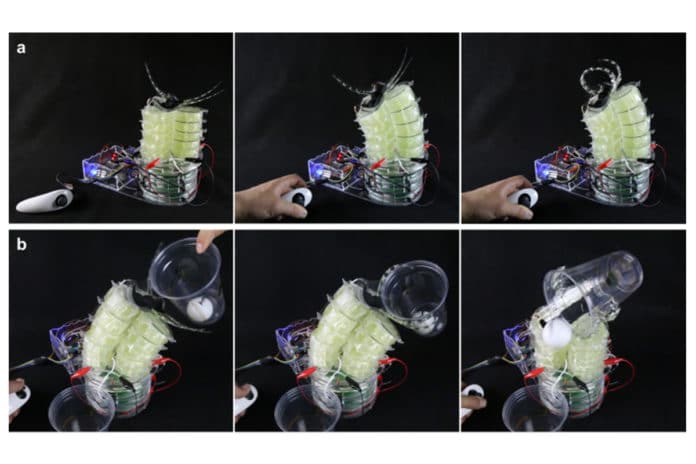The field of soft robotics challenges the conventional definition of a robot by replacing motors, gears, and metal with components inspired by those found in biological systems. Every advancement in this field brings researchers one step closer to developing wearable, surgical and collaborative robots that could safely and effectively help humans.
That’s why researchers in the Department of Mechanical Engineering at the University of Colorado Boulder have released a toolkit to show scientists, hobbyists, and entrepreneurs how to create their own artificial muscles.
Soft robots integrated with sensory perception and motion allow these robots to navigate environments with high levels of adaptability and dexterity.
Back in January 2018, Keplinger’s lab introduced the HASEL (Hydraulically Amplified Self-healing ELectrostatic) actuator, a new type of artificial muscle demonstrating impressive strength, speed, and efficiency. HASEL actuators with muscle‐like performance achieve all three basic modes of actuation (expansion, contraction, and rotation).
This toolkit utilizes easy‐to‐implement methods, inexpensive fabrication tools, commodity materials, and off‐the‐shelf high‐voltage electronics thereby enabling a wide audience to explore HASEL technology. The actuators created from this toolkit achieve large strain, extreme speed, and high specific power yields soft actuators that jump without power‐amplifying mechanisms.

Since then, the group has developed a portable electronics package that allows the robots to operate without being tethered.
And now, the Keplinger research group is taking that technology to the public. In the toolkit, the team provides a framework that enables you to prototype, manufacture, test, and power HASEL actuators. For a few dollars, anyone with a dedicated interest can use it.
“It is remarkable that the artificial muscles created with the introduced techniques demonstrate performance that drastically exceeds previously reported HASEL actuators,” said Assistant Professor Christoph Keplinger.
Read more: New fiber-based artificial muscles
The toolkit will allow the users to create several bio-inspired robots, for instance, an artificial scorpion tail that mimics the high-speed strike of a scorpion, twisting actuators that resemble tendrils of various plant species, or an artificial elephant trunk that can be used for grasping and manipulating delicate objects.
Though some soft robots are starting to find commercial use in industrial automation, there is a substantial need for the technology in areas directly impacting human life, Keplinger said. This is why several members of the Keplinger Research Group founded Artimus Robotics, a company spun out of CU that is commercializing the HASEL technology.
“HASEL is only useful for others if they can easily adapt, explore and push the boundaries of this new technology,” said Shane Mitchell, a mechanical engineering graduate student in the lab. “We’re excited about moving soft robotics out of the lab and into the real world.”
The toolkit is published in journal Advances science, for more details about the actuators, you can check it out.
